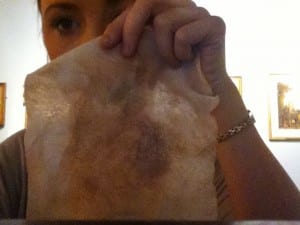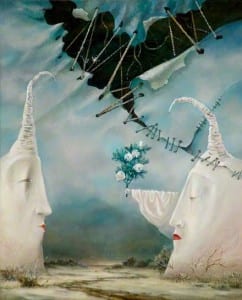‘People had a real familiarity with the space that was being worked with yet they were invited to experience the environment from a new perspective due to the performance that was enacted within it.’ (Govan 2006, p.122)
On 18th March, after many weeks of experimentation and development of our ideas, we were given the opportnity to test out a section of our performance in front of members of the class and any other members of the public who happened to be visiting the Usher Gallery. It was vital for us to get some feeback from our peers so we could be assured we were moving in the right direction, see that our performance communicates as we hoped or learn where/what we were lacking. There were particular areas in which we felt may not reflect the ideas behind them accuratley. For example, during our experimentation process with makeup, we were fascinated by the appearance of a dirty make up wipe and how something which appears so perfect initially, eventually descends into a filthy rag.
To reflect this in our performance we came up with an idea which would also decide our choice of costume. We wanted to show side by side the result we are looking for by applying makeup and also the substance that is left afterwards. This resulted in our desicion to wear white clothing during our piece and use this to remove the makeup rather than the conventional products; metaphorically becoming giant makeup wipes. What we hoped would become clear after this was our intention to reveal the negativity behind masking the real thing or becoming something idealised; which you are not. When we tried this out on the day we were pleased with the feedback we recieved and also how our audience began to think over what we hoped they would. For example they were struck by the duration of time in which it took us to apply the makeup and we were happy they picked up on this because our general approach is to show something real and everyday using the real time scale. We felt successful in delivering the message we intended to.
We are now trying to push our piece to the right standard leading up to the performance day which will mean more experimentation in the Usher Gallery ensuring we are happy with what we are revealing and where we are doing it. Ideally we would love for our audience to enjoy seeing something new and different in the art gallery but also appreciate its coherance with the rest of the art work.
Work cited
Govan, E., et al (2006) Making a Performance:
Devising Histories and Contemporary Practices, London and New York: Routledge


